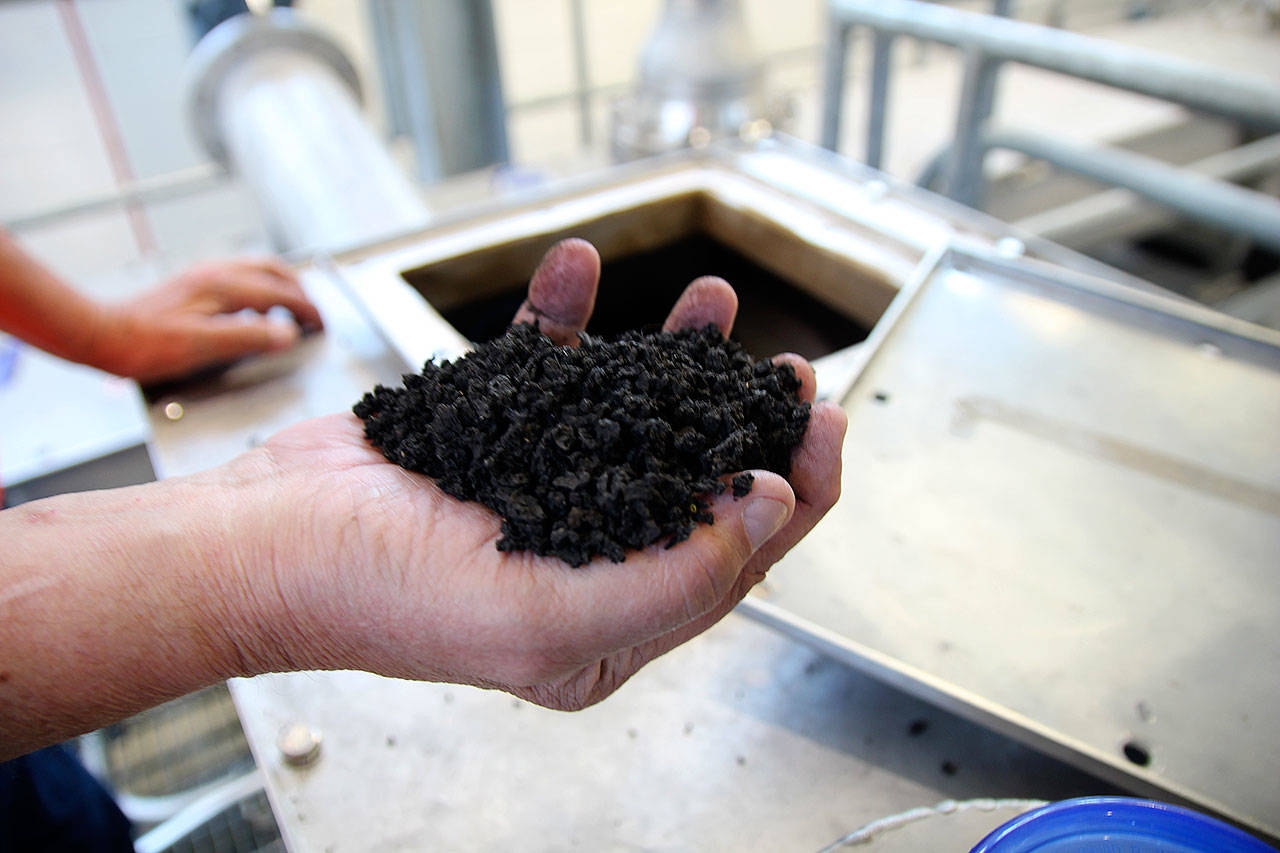Oak Harbor’s new sewage treatment plant isn’t quite living up to the odor-free promise, but operators are hoping the unfortunate stink will be eliminated soon.
The biosolids dryer was up and running this week, churning out crunchy, black stuff that is free of pathogens and certified for use in gardens. When the complex machine was switched on a couple months ago, the smell was so bad that it was shut down.
Brett Arvidson, project manager for the treatment plant, said operators are “85 percent there” when it comes to cutting the odor.
“People should be able to eat their lunch in that room when we’re finished,” he said.
City leaders promised that the plant would be odor-free after deciding to build it adjacent to the waterfront Windjammer Park. Residents were especially sensitive to the siting of the campus of sewage-treatment buildings because the former plant had been built in the middle of the park, next to the children’s playground, and would occasionally spread a blanket of feces-odor across the property.
The city council invested $4.5 million in a high-tech odor control system, which includes activated carbon filtration and a fan system that pushes tainted air skyward. A complex of high-powered fans circulates air from the headworks and the dryer buildings through odor-eliminating structures.
Optimizing the circulation of the air in the dryer building will be key to eliminating smells altogether, Arvidson said.
In 2015, council members had several options to choose from when it came to biosolids disposal. They decided to install the gas-power, forced-air dryer, which at $14.5 million was the most expensive choice — but also the most environmentally friendly and high-tech one.
The other options would have been to dispose of the stuff in a landfill or stabilize it with lime and truck it to Eastern Washington.
The plant went online last fall — and was odor-free, at least on the outside — but the dryer has been the last piece of the puzzle. The city purchased the complex machine from a company in Germany and even sent a technician on a tour of German plants that use the technology.
Back home, operators happened to test the dryer when a third grade class was touring the plant in April. The odor was pretty unbearable, which both delighted and grossed out the students.
Since then, operators have been working with the company to fix parts and optimize the system.
The building that houses the dryer looks like a scene out of Willy Wonka’s Chocolate Factory, with materials moving up and down in clear tubes, large vats churning and various pipes sprouting here and there. Arvidson said the technology actually shares similarities with bakeries.
In fact, the world of sewage treatment employs a lot of food-related terminology.
The material enters the building as activated sludge, which Arvidson said has the consistency of chocolate milk. A centrifuge removes much of the water, creating a pudding-like product known as cake.
The unique thing about the system, Arvidson said, is that it combines the cake with the wet stuff to create a mixture that’s easy to spread thin on an industrial cookie sheet that slowly makes its way through the convection-oven-like dryer.
“It’s like cooking a steak,” he said. “You don’t want it burned on the outside and pink in the middle.”
Under the rules of sewage treatment, the material has to be cooked at a temperature of at least 180 degree for 30 minutes. Currently, it’s cooking at 250 degree for two hours. The operators are probably overcooking it, Arvidson said, but they want make sure all the bad “bugs” are killed.
The dryer will likely have to be fired up just twice a week to process the sludgy mixture.
City leaders believe there will be a market for the dried material, which is Class A biosolids and a weak fertilizer. They talked about selling it back to the residents who produced and flushed the raw material, but recent discussions have focused on the possibility of contracting with a nursery or similar business.
“We’re not going to get a lot of money out of it,” Arvidson admitted, “but we won’t be paying for disposal.”



